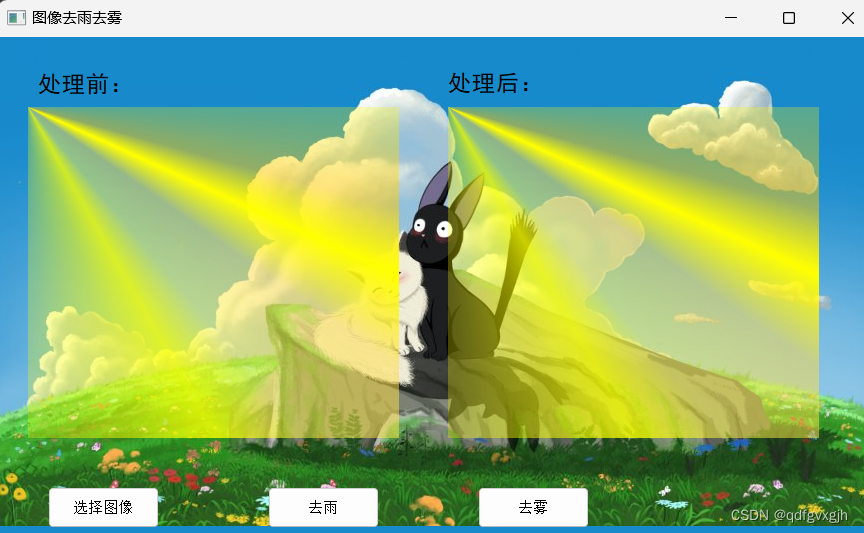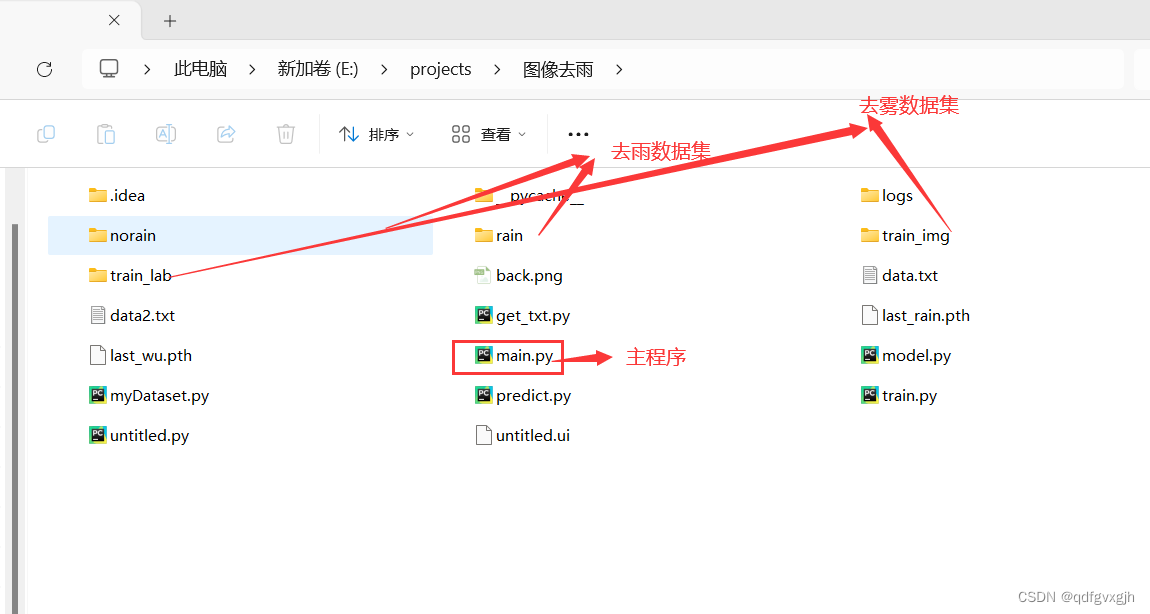基于深度学习的图像去雨去雾
文末附有源码下载地址
b站视频地址: https://www.bilibili.com/video/BV1Jr421p7cT/
基于深度学习的图像去雨去雾,使用的网络为unet,
网络代码:
import torch
import torch.nn as nn
from torchsummary import summary
from torchvision import models
from torchvision.models.feature_extraction import create_feature_extractor
import torch.nn.functional as F
from torchstat import stat
class Resnet18(nn.Module):
def __init__(self):
super(Resnet18, self).__init__()
self.resnet = models.resnet18(pretrained=False)
# self.resnet = create_feature_extractor(self.resnet, {'relu': 'feat320', 'layer1': 'feat160', 'layer2': 'feat80',
# 'layer3': 'feat40'})
def forward(self,x):
for name,m in self.resnet._modules.items():
x=m(x)
if name=='relu':
x1=x
elif name=='layer1':
x2=x
elif name=='layer2':
x3=x
elif name=='layer3':
x4=x
break
# x=self.resnet(x)
return x1,x2,x3,x4
class Linears(nn.Module):
def __init__(self,a,b):
super(Linears, self).__init__()
self.linear1=nn.Linear(a,b)
self.relu1=nn.LeakyReLU()
self.linear2 = nn.Linear(b, a)
self.sigmoid=nn.Sigmoid()
def forward(self,x):
x=self.linear1(x)
x=self.relu1(x)
x=self.linear2(x)
x=self.sigmoid(x)
return x
class DenseNetBlock(nn.Module):
def __init__(self,inplanes=1,planes=1,stride=1):
super(DenseNetBlock,self).__init__()
self.conv1=nn.Conv2d(inplanes,planes,3,stride,1)
self.bn1 = nn.BatchNorm2d(planes)
self.relu1=nn.LeakyReLU()
self.conv2 = nn.Conv2d(inplanes, planes, 3,stride,1)
self.bn2 = nn.BatchNorm2d(planes)
self.relu2 = nn.LeakyReLU()
self.conv3 = nn.Conv2d(inplanes, planes, 3,stride,1)
self.bn3 = nn.BatchNorm2d(planes)
self.relu3 = nn.LeakyReLU()
def forward(self,x):
ins=x
x=self.conv1(x)
x=self.bn1(x)
x=self.relu1(x)
x = self.conv2(x)
x = self.bn2(x)
x = self.relu2(x)
x=x+ins
x2=self.conv3(x)
x2 = self.bn3(x2)
x2=self.relu3(x2)
out=ins+x+x2
return out
class SEnet(nn.Module):
def __init__(self,chs,reduction=4):
super(SEnet,self).__init__()
self.average_pooling = nn.AdaptiveAvgPool2d(output_size=(1, 1))
self.fc = nn.Sequential(
# First reduce dimension, then raise dimension.
# Add nonlinear processing to fit the correlation between channels
nn.Linear(chs, chs // reduction),
nn.LeakyReLU(inplace=True),
nn.Linear(chs // reduction, chs)
)
self.activation = nn.Sigmoid()
def forward(self,x):
ins=x
batch_size, chs, h, w = x.shape
x=self.average_pooling(x)
x = x.view(batch_size, chs)
x=self.fc(x)
x = x.view(batch_size,chs,1,1)
return x*ins
class UAFM(nn.Module):
def __init__(self):
super(UAFM, self).__init__()
# self.meanPool_C=torch.max()
self.attention=nn.Sequential(
nn.Conv2d(4, 8, 3, 1,1),
nn.LeakyReLU(),
nn.Conv2d(8, 1, 1, 1),
nn.Sigmoid()
)
def forward(self,x1,x2):
x1_mean_pool=torch.mean(x1,dim=1)
x1_max_pool,_=torch.max(x1,dim=1)
x2_mean_pool = torch.mean(x2, dim=1)
x2_max_pool,_ = torch.max(x2, dim=1)
x1_mean_pool=torch.unsqueeze(x1_mean_pool,dim=1)
x1_max_pool=torch.unsqueeze(x1_max_pool,dim=1)
x2_mean_pool=torch.unsqueeze(x2_mean_pool,dim=1)
x2_max_pool=torch.unsqueeze(x2_max_pool,dim=1)
cat=torch.cat((x1_mean_pool,x1_max_pool,x2_mean_pool,x2_max_pool),dim=1)
a=self.attention(cat)
out=x1*a+x2*(1-a)
return out
class Net(nn.Module):
def __init__(self):
super(Net, self).__init__()
self.resnet18=Resnet18()
self.SENet=SEnet(chs=256)
self.UAFM=UAFM()
self.DenseNet1=DenseNetBlock(inplanes=256,planes=256)
self.transConv1=nn.ConvTranspose2d(256,128,3,2,1,output_padding=1)
self.DenseNet2 = DenseNetBlock(inplanes=128, planes=128)
self.transConv2 = nn.ConvTranspose2d(128, 64, 3, 2, 1, output_padding=1)
self.DenseNet3 = DenseNetBlock(inplanes=64, planes=64)
self.transConv3 = nn.ConvTranspose2d(64, 64, 3, 2, 1, output_padding=1)
self.transConv4 = nn.ConvTranspose2d(64, 32, 3, 2, 1, output_padding=1)
self.DenseNet4=DenseNetBlock(inplanes=32,planes=32)
self.out=nn.Sequential(
nn.Conv2d(32,3,1,1),
nn.Sigmoid()
)
def forward(self,x):
"""
下采样部分
"""
x1,x2,x3,x4=self.resnet18(x)
# feat320=features['feat320']
# feat160=features['feat160']
# feat80=features['feat80']
# feat40=features['feat40']
feat320=x1
feat160=x2
feat80=x3
feat40=x4
"""
上采样部分
"""
x=self.SENet(feat40)
x=self.DenseNet1(x)
x=self.transConv1(x)
x=self.UAFM(x,feat80)
x=self.DenseNet2(x)
x=self.transConv2(x)
x=self.UAFM(x,feat160)
x = self.DenseNet3(x)
x = self.transConv3(x)
x = self.UAFM(x, feat320)
x=self.transConv4(x)
x=self.DenseNet4(x)
out=self.out(x)
# out=torch.concat((out,out,out),dim=1)*255.
return out
def freeze_backbone(self):
for param in self.resnet18.parameters():
param.requires_grad = False
def unfreeze_backbone(self):
for param in self.resnet18.parameters():
param.requires_grad = True
if __name__ == '__main__':
net=Net()
print(net)
# stat(net,(3,640,640))
summary(net,input_size=(3,512,512),device='cpu')
aa=torch.ones((6,3,512,512))
out=net(aa)
print(out.shape)
# ii=torch.zeros((1,3,640,640))
# outs=net(ii)
# print(outs.shape)
主题界面显示及代码:

from PyQt5.QtGui import *
from PyQt5.QtWidgets import *
from untitled import Ui_Form
import sys
import cv2 as cv
from PyQt5.QtCore import QCoreApplication
import numpy as np
from PyQt5 import QtCore,QtGui
from PIL import Image
from predict import *
class My(QMainWindow,Ui_Form):
def __init__(self):
super(My,self).__init__()
self.setupUi(self)
self.setWindowTitle('图像去雨去雾')
self.setIcon()
self.pushButton.clicked.connect(self.pic)
self.pushButton_2.clicked.connect(self.pre)
self.pushButton_3.clicked.connect(self.pre2)
def setIcon(self):
palette1 = QPalette()
# palette1.setColor(self.backgroundRole(), QColor(192,253,123)) # 设置背景颜色
palette1.setBrush(self.backgroundRole(), QBrush(QPixmap('back.png'))) # 设置背景图片
self.setPalette(palette1)
def pre(self):
out=pre(self.img,0)
out=self.cv_qt(out)
self.label_2.setPixmap(QPixmap.fromImage(out).scaled(self.label.width(),self.label.height(),QtCore.Qt.KeepAspectRatio))
def pre2(self):
out=pre(self.img,1)
out=self.cv_qt(out)
self.label_2.setPixmap(QPixmap.fromImage(out).scaled(self.label.width(),self.label.height(),QtCore.Qt.KeepAspectRatio))
def pic(self):
imgName, imgType = QFileDialog.getOpenFileName(self,
"打开图片",
"",
" *.png;;*.jpg;;*.jpeg;;*.bmp;;All Files (*)")
#KeepAspectRatio
png = QtGui.QPixmap(imgName).scaled(self.label.width(),self.label.height(),QtCore.Qt.KeepAspectRatio) # 适应设计label时的大小
self.label.setPixmap(png)
self.img=Image.open(imgName)
self.img=np.array(self.img)
def cv_qt(self, src):
#src必须为bgr格式图像
#src必须为bgr格式图像
#src必须为bgr格式图像
if len(src.shape)==2:
src=np.expand_dims(src,axis=-1)
src=np.tile(src,(1,1,3))
h, w, d = src.shape
else:h, w, d = src.shape
bytesperline = d * w
# self.src=cv.cvtColor(self.src,cv.COLOR_BGR2RGB)
qt_image = QImage(src.data, w, h, bytesperline, QImage.Format_RGB888).rgbSwapped()
return qt_image
if __name__ == '__main__':
QCoreApplication.setAttribute(QtCore.Qt.AA_EnableHighDpiScaling)
app=QApplication(sys.argv)
my=My()
my.show()
sys.exit(app.exec_())
项目结构:

直接运行main.py即可弹出交互界面。
项目下载地址:下载地址-列表第19







 本文介绍了如何使用深度学习中的Unet网络对图像进行去雨去雾处理,同时展示了如何将此模型与PyQt5界面集成,实现实时图像处理功能。作者还提供了Resnet18、SEnet、UAFM等模块的代码实现和预处理方法的示例。
本文介绍了如何使用深度学习中的Unet网络对图像进行去雨去雾处理,同时展示了如何将此模型与PyQt5界面集成,实现实时图像处理功能。作者还提供了Resnet18、SEnet、UAFM等模块的代码实现和预处理方法的示例。














 2475
2475











 被折叠的 条评论
为什么被折叠?
被折叠的 条评论
为什么被折叠?








